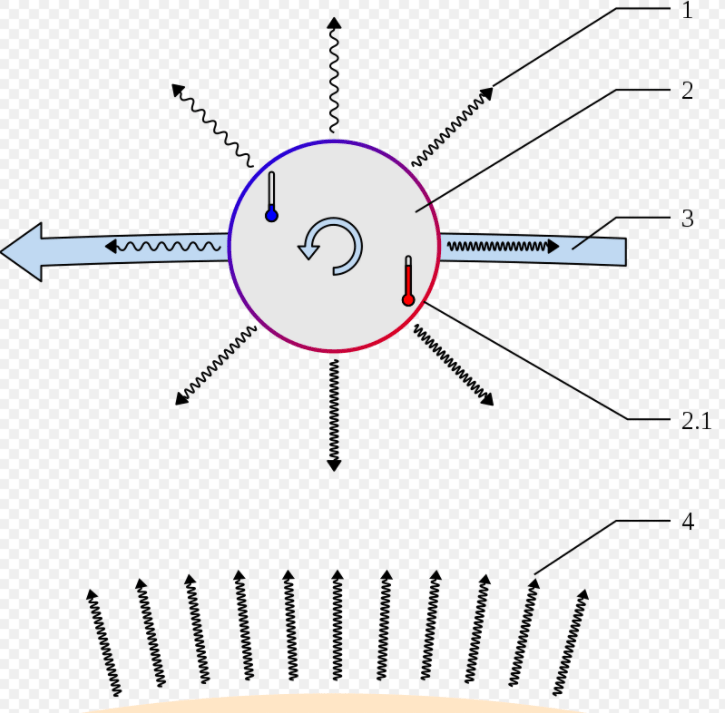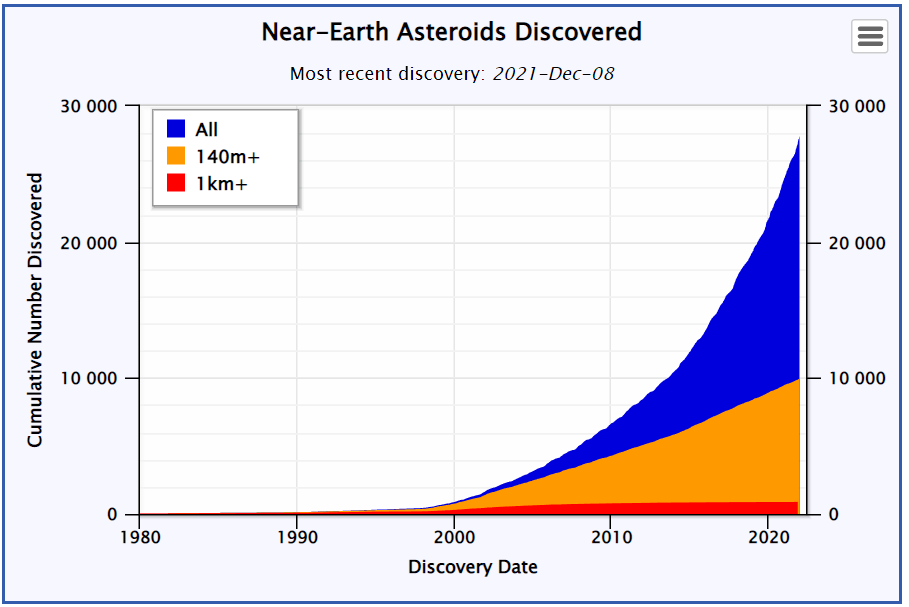An asteroid striking Earth is a genuine possibility. There are tens of thousands of asteroids classified as Near-Earth Asteroids (NEAs), and we’re finding around 3,000 more each year. The number of new detections will see an uptick in the next few years as better survey telescopes come online.
Now NASA has developed a new system to classify all those asteroids and better evaluate impact probabilities.
There are various classifications for objects that come close to Earth.
A Near-Earth Object (NEO) has a perihelion of less than 1.3 astronomical units (AU.) A NEO can be either a Near-Earth Asteroid (NEA) or a Near-Earth Comet (NEC). If a NEO follows an orbit that crosses Earth’s, and if the NEO is larger than 140 meters (460 ft) in diameter, it’s a Potentially Hazardous Object (PHO.) Most PHOs are asteroids, and only a few are comets.
We know of about 27,000 NEAs and just over one hundred Near-Earth Comets. Those numbers will only grow, not shrink, and NASA needed a better way to assess the impact probabilities for all those objects. To do so, they’ve developed a next-generation algorithm.
Asteroids and comets aren’t travelling through space chaotically and unpredictably. In the distant past, things were more chaotic in the young Solar System, as planets migrated and asteroids were thrown around as a result. But now, NEOs follow predictable orbits. So even though there are tens of thousands of them, the situation is manageable.
But, there’s a little chaos and unpredictability throughout nature, and asteroids are no exception. There are also some tiny uncertainties in asteroids’ positions. There’s no room for carelessness when you only have one planetary home.
NASA maintains a NEO monitoring system at the Center for Near-Earth Object Studies (CNEOS) at JPL in California. It’s integrated with NASA’s Planetary Defense Coordination Office (PDCO). On their website, CNEOS says, “The Center for Near-Earth Object Studies (CNEOS) computes high precision orbits for Near-Earth Objects (NEOs), predicts their future motions, assesses their impact hazard, and makes these results available on this website.”
When scientists compute a NEO’s orbit, their data is imperfect. Different telescopes or observatories can come up with slightly different positions for any given asteroid. And though the differences are slight, they can result in different computed orbits. So CNEOS uses an algorithm called Sentry to analyze a range of possible orbits for each asteroid. Then it determines probabilities for an impact with Earth reaching 100 years into the future.
The original Sentry was very powerful.
“The first version of Sentry was a very capable system that was in operation for almost 20 years,” said Javier Roa Vicens, who led the development of Sentry-II while working at JPL. “It was based on some very smart mathematics: In under an hour, you could reliably get the impact probability for a newly discovered asteroid over the next 100 years – an incredible feat.”
Though Sentry is a powerful system, it has its drawbacks. Its power was in computing orbits by taking into account all the gravitational influences in the inner Solar System. But it’s not only gravity that shapes an asteroid’s orbit. Some asteroids are called “special cases” because of the Yarkovsky effect.
The Yarkovsky effect is named after the Polish-Russian engineer Ivan Osipovich Yarkovsky. Yarkovsky determined that small rotating objects in space would experience daily heating and that over time, that heating could induce small changes in the object’s orbit. The Yarkovsky effect is not that consequential on short time scales. But over decades and centuries, it can add up. The original Sentry didn’t take the Yarkovsky effect into account.
 This illustration explains the Yarkovsky effect. The Yarkovsky effect can alter the orbit of smaller NEOs. Image Credit: By Graevemoore at English Wikipedia, CC BY-SA 3.0, https://commons.wikimedia.org/w/index.php?curid=4314576
This illustration explains the Yarkovsky effect. The Yarkovsky effect can alter the orbit of smaller NEOs. Image Credit: By Graevemoore at English Wikipedia, CC BY-SA 3.0, https://commons.wikimedia.org/w/index.php?curid=4314576Now NASA has implemented Sentry’s successor, Sentry-II. Sentry-II won’t suffer from the same limitation that its predecessor did.
“The fact that Sentry couldn’t automatically handle the Yarkovsky effect was a limitation,” said Davide Farnocchia, a navigation engineer at JPL who also helped develop Sentry-II. “Every time we came across a special case – like asteroids Apophis, Bennu, or 1950 DA – we had to do complex and time-consuming manual analyses. With Sentry-II, we don’t have to do that anymore.”
The original Sentry had another limitation: it struggled to accurately predict the impact probabilities for asteroids that went through extremely close encounters with Earth. Earth’s gravity is significant to a small NEA, and it isn’t easy to compute an NEA’s altered orbit into the future after such an encounter. Post-Earth trajectories can be altered dramatically by a close encounter with Earth, and those calculations had to be done manually.
But Sentry-II is equipped to handle that problem. And though there aren’t a profuse number of special cases, their number will grow as we detect more and more NEAs.
“In terms of numbers, the special cases we’d find were a very tiny fraction of all the NEAs that we’d calculate impact probabilities for,” said Roa Vicens. “But we are going to discover many more of these special cases when NASA’s planned NEO Surveyor mission and the Vera C. Rubin Observatory in Chile go online, so we need to be prepared.”
The Vera C. Rubin Observatory will be a powerful tool for detecting NEAs. It’ll image each area of the sky about 1000 times in its ten-year survey. And it’ll do so with a powerful 3,200-megapixel camera. The Rubin will image the entire visible sky every two nights, and Asteroids will have nowhere to hide.
The NEO Surveyor is a space telescope scheduled for launch in 2026. It’ll survey in infrared since most of the ones detectable in optical light have already been found. As a NEO approaches the Sun, it gets warmed. When it releases that energy in the infrared, NEO Surveyor will be watching.
 This chart from CNEOS shows the cumulative number of known Near-Earth Asteroids (NEAs) versus time. It shows totals for NEAs of all sizes, those NEAs larger than ~140m in diameter and those larger than ~1km in diameter. The dramatic rise in detections in the last two decades is likely to continue as the NEO Surveyor and the Vera C. Rubin facilities start operating. Image Credit: CNEOS
This chart from CNEOS shows the cumulative number of known Near-Earth Asteroids (NEAs) versus time. It shows totals for NEAs of all sizes, those NEAs larger than ~140m in diameter and those larger than ~1km in diameter. The dramatic rise in detections in the last two decades is likely to continue as the NEO Surveyor and the Vera C. Rubin facilities start operating. Image Credit: CNEOSThe NEO Surveyor and the Vera C. Rubin Observatory could lead to a veritable deluge of NEA detections, and NASA needed a new way to compute their orbits effectively.
In a way, asteroids are kind of like electrons. We can’t know an electron’s exact position and velocity, so we compute a region where it might be. We can only know the different probabilities of an electron being in one position.
Detecting NEA orbits is similar. When a new NEA is detected, more than one telescope or observatory observes it. Each one reports the observed position to the Minor Planet Center. Then CNEOS takes that data and calculates the asteroid’s most likely orbit. But the most likely orbit is actually a range, and the true orbit is somewhere inside that range.
This is where Sentry-II’s power becomes evident.
The original Sentry relied on some assumptions to compute an asteroid’s orbit. It selected evenly-spaced points in the uncertainty region, with each point representing a slightly different possible current location of the asteroid. Then it would project into the future and watch as these virtual asteroids orbited the Sun. If any came near the Earth, it would then look more closely and determine if any of the points would potentially impact Earth. If they did, it would calculate the probability of an impact. Part of the problem is that uncertainties grow over time.
This animation shows an example of how the uncertainties in a near-Earth asteroid’s orbit can evolve with time. After such an asteroid’s close encounter with Earth, the uncertainty region becomes more extensive, making the possibility of future impacts more challenging to assess.Sentry-II handles it differently.
It takes thousands of points within the uncertainty region without assuming how the uncertainty region might evolve over time. Then, the algorithm asks itself: What are the possible orbits within the entire region of uncertainty that could hit Earth?
Mostly, it boils down to one crucial difference: Sentry-II can zero in on low-probability impact scenarios that its predecessor may miss.
A JPL/NASA press release likens it to finding a needle in a haystack. The larger the region of orbital uncertainty for an asteroid is, the larger the haystack is. And each needle is a possible impact scenario.
The original Sentry would poke randomly at points on a single line through the haystack, searching for possible impact scenarios. The AI assumed that this was the optimal way to search for and find needles or impact scenarios.
But Sentry-II does it differently. It doesn’t make any assumption about a line of possible impacts through the “haystack.” Instead, it uses thousands of “magnets,” which it throws randomly throughout the whole haystack. Those magnets are then attracted to the “needles” or impact scenarios.
“Sentry-II is a fantastic advancement in finding tiny impact probabilities for a huge range of scenarios,” said Steve Chesley, senior research scientist at JPL. He led the development of Sentry and collaborated on Sentry-II. “When the consequences of a future asteroid impact are so big, it pays to find even the smallest impact risk hiding in the data.”
In our modern age of computerized and automated astronomical surveys and observations, AI, machine learning, and super-computers play an increasingly important role. Observatories like the Vera C. Rubin Observatory will generate enormous amounts of data—far too much to handle manually. We need AI and machine learning to make sense of it all.
It might even be AI that saves us from an asteroid impact.

